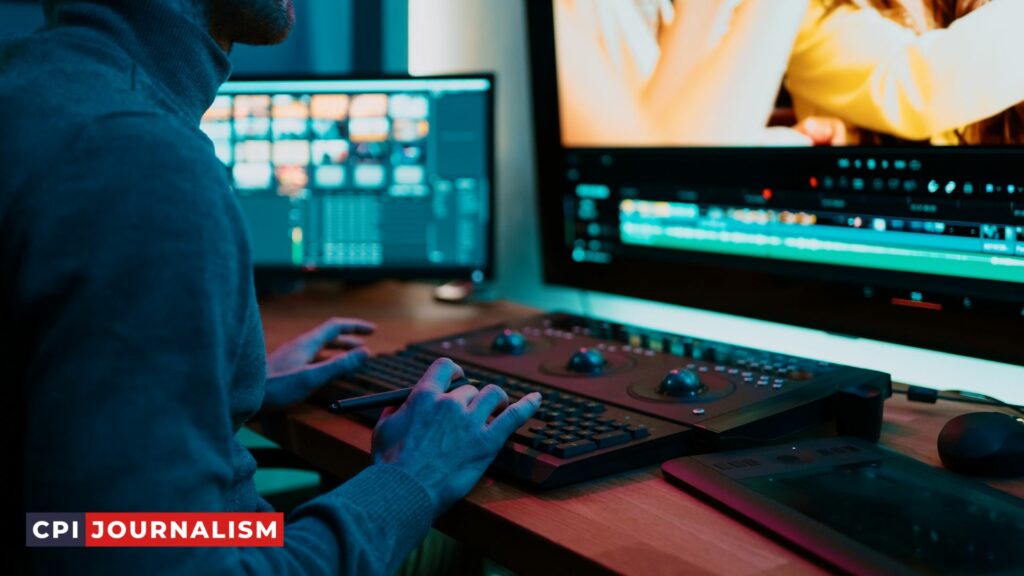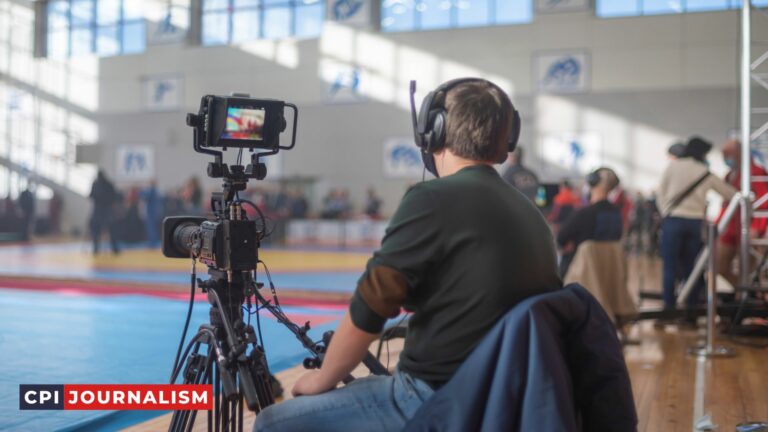How Do Sports Journalists Use Video To Enhance Their Stories?
As an experienced journalist, I have seen firsthand how video has become an essential tool for sports journalists looking to enhance their stories.
Video allows journalists to capture the excitement and emotion of the stories they are covering in a way that still images and words alone cannot. In this article, I will discuss how sports journalists are using video to add depth, emotion, and excitement to their stories.
I will share my own experiences and explain some of the techniques that are being used by journalists to make their stories stand out from the rest.
A. Benefits of Using Video
Video is one of the most powerful tools available to sports journalists. Not only does it allow them to capture events as they happen, but it can also be used to tell stories in a more engaging way.
Here are some of the key benefits of using video for sports journalism:
1. Adds Visual Impact: Video footage gives sports stories an extra layer of impact. It can bring to life the emotion of a game in a way that words alone cannot.
2. Captures Action: Video is a great way to capture the action as it happens. It allows journalists to get up close and personal with their subjects and provide viewers with an immersive experience.
3. Enhances Narrative: Video can be used to enhance the narrative of a story. It can be used to show key moments, interviews, and reactions to the events being covered.
4. Increases Engagement: Using video can help to increase audience engagement. It can be used to capture the excitement of a game, or to provide viewers with an intimate insight into the lives of the athletes and coaches.
5. Increases Reach: A well-produced video can help to increase the reach of a story. It can be shared on social media and embedded on websites, giving the story a much wider audience.
II. How Sports Journalists Use Video to Enhance Their Stories
In today’s digital age, video has become an invaluable tool for sports journalists. Video can be used to capture highlights and stories from sports events, to interview athletes and coaches, and to create engaging content for readers and viewers.
By using video, sports journalists can add a visual dimension to their stories that otherwise would not exist.
One of the most common ways sports journalists use video is to capture highlights from games and other sporting events. This could mean recording an amazing goal or a spectacular play, or capturing the reactions of fans and athletes in the stands and on the field.
Video can also be used to document post-game press conferences, allowing readers and viewers to get the play-by-play analysis of the game from the athletes and coaches themselves.
Video can also be used to create unique content for readers and viewers. This could include creating a short documentary-style feature on an athlete or team, or interviewing athletes and coaches to get a better understanding of their motivations and personalities.
Video can also be used to create clips for social media, giving fans an inside look into what athletes and teams are doing on and off the field.
Finally, video can be used to create promotional content for sports teams and organizations. This could include creating highlight reels of teams’ past successes, or creating a video of the team’s upcoming season and goals. These videos can be used to build excitement for the team and to promote ticket sales.
Overall, video has become an essential tool for sports journalists, allowing them to tell stories in a more dynamic and engaging way. By utilizing video, sports journalists can capture and create unique content that can be used to engage readers and viewers.
A. Capturing the Action
As an experienced sports journalist, I understand the importance of capturing the action when telling a story.
In order to fully communicate the excitement, intensity, and emotion of the moment, it is essential to have video footage to accompany the narrative. To do this, I always take steps to ensure that I am in the best position to capture the action.
First, I make sure to research the game or event prior to arriving. This gives me a good understanding of the action and helps me identify the most important moments to capture. I also make sure to arrive early and scout out the best possible angles to get the best shots.
Once I am set up, I make sure to capture multiple angles of the action. This includes shooting from a variety of heights and distances and using different lenses to provide a variety of perspectives. I also make sure to capture both wide and close-up shots, as well as shots in slow motion.
Finally, I make sure to have a plan for what shots I will take and when. I also make sure to take a few extra shots of the same action, just in case something goes wrong. This ensures that I have enough footage to put together a compelling story.
By taking the time to plan ahead and capture the action in multiple angles, I can ensure that I have the footage I need to tell an exciting and engaging story.
B. Interviews
Interviews are a crucial part of any sports journalist’s toolkit. They allow for a greater level of connection with the subject, and can provide insight that a simple video of an event can’t.
For instance, if a journalist is covering the story of a Major League Baseball player who recently made a game-winning hit, an interview with that player can provide a more personal, in-depth look into the moment and why it was so special.
The key to conducting effective interviews for sports journalists is to ask the right questions. Get the subject to talk in detail about the event they were involved in, or if it’s a profile piece, ask them to explain a bit about their background and journey.
Make sure to also ask open-ended questions that allow the subject to provide more than a simple yes or no answer.
When it comes to capturing the interview, video is the way to go. Video allows for a more personal connection with the subject, and it can also be used to convey the emotions and energy of the interview.
Additionally, video interviews can be shared with larger audiences, as they can easily be embedded into articles and shared on social media platforms.
To ensure a successful video interview, make sure to have the right equipment. A good quality microphone, a camera with a decent resolution, and a tripod to keep the camera steady are all must-have items when conducting a video interview.
Additionally, make sure the background is uncluttered, as this will help make the subject look more presentable.
Finally, make sure to have a plan for the interview. Create a list of questions beforehand, and map out the structure of the interview. This will help ensure that the interview remains on track, and that all the necessary information is captured.
By following these tips, sports journalists can use video interviews to enhance their stories and create compelling visuals that can easily be shared with larger audiences.
C. Behind-the-Scenes Footage
Behind-the-scenes footage can be an invaluable tool for sports journalists looking to enhance their stories. This footage can provide a unique insight into the world of professional sports, offering viewers a glimpse into the inner workings of the teams and organizations.
It can also provide a more humanizing look at athletes, allowing audiences to get to know them better.
Behind-the-scenes footage can come in many forms. It can be as simple as a quick tour of the locker room or a candid interview with a player or coach. It can also be more involved, such as a feature-length documentary that follows a team through an entire season.
The possibilities are virtually endless, and the footage can be used in a variety of ways.
For instance, behind-the-scenes footage can be used to provide background information for a story. It can also be used to illustrate a point or illustrate a player’s journey from start to finish. It can even be used to introduce a new topic or transition from one idea to the next.
Behind-the-scenes footage is also a great way to engage viewers. This type of footage is often more personal and intimate than traditional video footage, allowing viewers to feel connected to the story.
By providing personal and candid insights into the world of professional sports, behind-the-scenes footage can help to draw viewers in and keep them interested.
In conclusion, behind-the-scenes footage can be an invaluable tool for sports journalists looking to enhance their stories. It can provide a unique and personal insight into the world of professional sports, allowing viewers to get to know athletes on a more human level.
It can also be used to introduce new topics or transition from one idea to the next. By using this type of footage, sports journalists can create stories that are more engaging and memorable for their audiences.
D. Creative Storytelling
Creative storytelling is one of the most essential skills for sports journalists, and video can be a great tool for bringing these stories to life. Video can help capture the emotion and excitement of a game, allowing the viewer to feel like they’re in the middle of the action.
It can also be used to create compelling and vivid stories that demonstrate the power of sports journalism.
One of the most effective ways to use video in storytelling is to focus on the individual characters in the story. By focusing on a single athlete or team, journalists can create compelling stories that show the human side of sports.

Through interviews, highlights, and commentary, journalists can showcase the emotions and motivations of the athletes and teams they cover.
In addition, video can also be used to tell stories with a narrative arc. By tracking the progress of a team over the course of a season, or following an athlete’s journey from the start of their career to the present, journalists can create compelling stories that draw viewers in.
This type of storytelling can be particularly effective when covering a team or athlete that is on the verge of breaking through and achieving success.
Ultimately, video can be a powerful tool for sports journalists who want to tell creative and engaging stories.
By focusing on the individual characters and tracking their progress, journalists can create compelling stories that draw viewers in and demonstrate the power of sports journalism.
III. Benefits of Using Video
Video is a powerful tool for sports journalists, and there are several benefits to using video in their stories. Firstly, it can help to provide a more immersive and engaging experience for readers.
Video can capture the atmosphere of a game or match, and provide an insight into the emotions of the players and fans. This helps to bring the story to life and give readers a more vivid understanding of the event.
Another benefit of using video is that it can help to illustrate complex concepts or tactics in an easily digestible way. Video can show the action as it happened in real time, allowing readers to gain a better understanding of the strategies involved.
This can be especially useful for sports that involve a lot of technical detail, such as cricket or American football.
Finally, video can be used to add an extra layer of analysis to a story. Journalists can provide commentary on the action, or highlight key moments in the match, giving readers a better understanding of the game and its key players.
This is especially useful for sports stories that involve a lot of complex analysis and tactical decisions.
Overall, video is a powerful tool for sports journalists, and can help to provide readers with an engaging and immersive experience. It can be used to illustrate complex concepts and provide an extra layer of analysis, giving readers a better understanding of the story.
A. Increased Engagement
One of the most powerful ways sports journalists use video to enhance their stories is to increase engagement with their readers.
Video can be used to capture the excitement of the moment, provide visual context to the story, and to engage the reader in a more dynamic way.
For example, a reporter covering a football game can use video to show the crowd cheering, the players celebrating a touchdown, or the coaches discussing strategies on the sidelines. All of these visuals can help the reader experience the game in a more immersive way.
Video can also be used to supplement traditional reporting by providing additional context to the story. A journalist covering a tennis match, for example, can use video to show the court and ball speed, which can help the reader better understand the strategy and tactics of the players.
Video can also be used to provide interviews with those involved in the game, including coaches, players, and even spectators.
Interviews can provide valuable insights into the game and the players, adding a human element to the story that resonates with readers.
Finally, video can be used to create exciting multimedia stories. Using video and photos, journalists can create immersive packages that combine multiple angles and perspectives to tell the story.
In short, video is a powerful tool for sports journalists, allowing them to enhance their stories, engage readers, and create immersive multimedia experiences.
B. More Comprehensive Coverage
Video is an essential tool for sports journalists looking to enhance their stories. More comprehensive coverage involves using video to capture more than just the action on the field.
For example, pre-game interviews can provide a human interest angle to a story. It can also be used to capture team or player reactions to a game’s outcome.
Video is also a great way to provide context to a particular story. It can be used to capture the atmosphere of a game, such as a packed stadium or a rowdy crowd.
It can also be used to capture the sights and sounds of a game, such as a crowd cheering or a player celebrating a goal.
For stories that involve more than one team, video can be used to provide a comparison between two teams. By showing how two teams approach the same game differently, video can help to illustrate how a team’s strategy impacts its success.
In addition, video can be used to capture behind-the-scenes footage or to access unique angles of a game.
For instance, a journalist could capture footage of a team’s locker room before a game or gain access to an aerial view of a stadium.
Finally, video can be used to capture moments that are too fleeting to capture in words. It can be used to capture the emotion of a particular moment in a game, such as a team’s celebration after a big victory.
Video can also be used to capture moments of individual brilliance, such as a player’s amazing goal or a spectacular save.
By using video to capture the sights, sounds, and emotions of a game, sports journalists can provide a more comprehensive coverage of their stories. Video can help to provide context and insight, as well as capture the moments that words alone cannot.
C. Improved Storytelling
As an experienced sports journalist, I can attest to the power of video in improving storytelling. When used effectively, video can be an invaluable tool in conveying the emotion, impact, and intensity of a sporting event to an audience.
For example, when used strategically, video can be used to convey the excitement of a game. It can be used to capture the energy of a packed stadium, the cheers of the crowd, and the impact of a game-winning play.
Video can also be used to convey the emotion of a game, such as the disappointment of a losing team or the joy of a winning team.
In addition, video can be used to capture the intensity of a game. It can be used to show the physicality of a sport, the skill of an athlete, or the intensity of a rivalry.
It can also be used to capture the strategies of a team, the strategies of a coach, or the strategies of an athlete.
Finally, video can be used to tell a story. It can be used to show how a team has progressed over time, how a player has developed, or how a rivalry has grown.
By using video strategically to convey emotion, impact, and intensity, sports journalists can create compelling stories that capture the true essence of sports.
D. Creative Storytelling
Creative storytelling is a powerful tool for sports journalists looking to create compelling video content. With the right approach, video can be a great way to bring stories to life and engage viewers.
Here are some tips for using video to tell stories more creatively.
• Embrace Different Perspectives: Don’t be afraid to explore different angles and perspectives when telling a story. Use a variety of camera angles, interviews, and visual effects to create a more dynamic narrative.
• Focus on Emotion: Use video to bring out the emotion of a story. From the facial expressions of athletes, to the reactions of fans, to the sounds of the game, video can be a great way to capture and convey emotion.
• Create Suspense: Create tension and anticipation by setting up a story and then building up to the climax. Use techniques such as slow motion, jump cuts, and voice-over narration to guide viewers through the story.
• Showcase the Human Element: Sports are more than just the action on the field. Use video to showcase the human side of sports, such as the fans, coaches, and athletes.
• Make it Interactive: Give viewers a chance to interact with the video by allowing them to participate in polls, quizzes, and other interactive elements.
By taking advantage of these creative storytelling techniques, sports journalists can create compelling video content that will engage and entertain viewers.
IV. Challenges of Using Video
As with many other aspects of journalism, there are a number of challenges associated with using video to enhance stories. One of the most common challenges is the cost involved.
The cost of equipment, editing software, and other resources can be prohibitively expensive, so it may not be feasible for smaller newsrooms to invest in them. Additionally, the time investment in shooting and editing video can be quite significant, and may not be worth the effort for certain stories.
Another key challenge is finding the right people to feature in the video, which can be a time-consuming process. It is important to find individuals who are knowledgeable and articulate, and who can adequately represent the story.

This can be particularly difficult when it comes to covering sports, as many athletes may not be comfortable speaking in front of a camera.
Finally, there is the challenge of distilling the story into a few minutes of video, as this requires a great deal of skill and understanding of the story, as well as a clear vision of how to present it.
It can be difficult to take a complex story and turn it into a concise and compelling video without sacrificing the key points.
These challenges can be daunting, but they are surmountable, and the rewards are great. With the right resources, the right people, and the right vision, sports journalists can use video to enhance their stories, tell them in new and exciting ways, and reach new audiences.
A. Accessibility
As a sports journalist, one of the most important tools to enhance storytelling is video. Video allows sports journalists to capture the action, emotions and atmosphere of a sporting event in a way that words alone cannot.
But it’s not just about capturing the action. It’s also about making the footage easily accessible to viewers.
The most important factor when accessing footage is ensuring that it is available from a variety of sources. Whether it be from a live broadcast, through a subscription service, or from a website, it’s important that viewers can access the footage in whatever way works best for them.
This means that the footage needs to be made available in a range of formats, such as HD, 4K, or even virtual reality.
In addition to this, it’s important to consider the accessibility of the footage. Is it available for free? Is it viewable on a range of devices, from smartphones to smart TVs?
Is it available in different languages? As a sports journalist, it’s important to think about these factors when deciding which footage to use.
Finally, it’s important to consider the legal implications of using video footage. Make sure to check the copyright of the video before using it, and always seek permission from the relevant parties before using footage of people. By following these guidelines, you can help ensure that your video content is accessible and legal.
B. Cost
As with any form of journalism, video can be a costly endeavor. It is important to be aware of the cost of video production in order to ensure that the video story is produced in the most cost-effective manner.
The cost of video production can be broken down into three main categories: equipment, personnel and post-production. Equipment can include cameras, lights, audio equipment, editing software, and other necessary items.
Personnel costs can include hiring a videographer, a sound technician, and an editor. Post-production costs can include color correction, audio mixing, and other types of post-production work.
When choosing a production company, it is important to make sure that the cost of their services is in line with the quality of the video and sound they are providing.
It is also important to make sure that the production company understands the needs of the story and can deliver the video story in a timely manner.
It is also important to remember that the cost of video production is not static. Depending on the complexity of the story, the cost of the video can increase or decrease.
For example, a story that requires special effects or additional footage may require more time and money to produce.
In conclusion, it is important to be aware of the cost of video production when creating a video story. By understanding the cost of video production and working with a production company that is right for the story, journalists can ensure that their video stories are produced in an effective and cost-efficient manner.
C. Technical Difficulties
For sports journalists, using video to enhance their stories can be a great way to engage readers. However, it’s important to keep in mind that video editing and production can present some technical difficulties.
First and foremost, it’s important to make sure that you have the right equipment for the job. Depending on the type of video you’re going to create, you may need a camera, microphone, lights, editing software, and other related equipment.
If you’re unfamiliar with these pieces of equipment, it’s important to take the time to learn how to use them properly.
Another technical difficulty you may encounter is the actual process of editing and producing the video. You may need to learn how to use video editing software, which can be a daunting task.
Additionally, you may need to make sure that the video is properly formatted and encoded to work correctly on the web.
Finally, you may need to make sure that you have the right hosting platform in order to share your video. You’ll need to make sure that the video is properly uploaded and optimized for playback.
Overall, using video to enhance your stories can be a great way to engage readers. However, it’s important to keep in mind that there may be some technical difficulties along the way.
It’s essential to make sure that you have the right equipment, that you understand the video editing and production process, and that you have the right hosting platform.
V. Conclusion
In conclusion, video is an invaluable tool for sports journalists. It can be used to provide visual evidence to support a story, to show viewers what happened during a game or event, and to create an immersive experience that readers can relate to.
Video also allows journalists to bring viewers closer to the action and to show them what the players, coaches, and other people involved in the story are thinking and feeling.
By using video creatively, sports journalists can build an emotional connection with their audience and create stories that stand out from the competition.
Video is an essential tool for sports journalists, and it can be used to create powerful, impactful stories. As technology advances, the possibilities for using video in sports journalism are only going to increase.
Video is an incredibly powerful tool, and it has the potential to revolutionize how we tell stories about sports.
A. Summary of How Sports Journalists Use Video to Enhance Their Stories
As an experienced sports journalist, I can attest to the importance of using video to enhance stories about sports. Video can provide a visual representation of the action and emotion of a sporting event, allowing readers to connect more deeply with the story.
It can also be used to provide context and additional information about the game or the players involved in it.
When it comes to using video to enhance stories, the most important thing is to capture the action in the moment. This can be done with a variety of digital cameras and even smartphones.
This allows the journalist to capture action shots in real time and edit them together into a cohesive story. Additionally, video can be used to provide background and context to the story, such as interviews with players and coaches and highlights of the game.
In addition to action shots and interviews, video can also be used to create a more engaging experience for the reader. This can be done by incorporating graphics, animation, and other visual elements into the video.
This can help to create a more immersive experience for the reader, allowing them to be drawn into the story and understand the nuances of the game more clearly.
Video is a powerful tool for sports journalists, and when used correctly, can help to enhance the story and engage the reader.
By capturing the action in the moment, providing background and context, and incorporating graphics and animation, video can help to create a more engaging experience for the reader.
B. Benefits Of Using Video
Using video to enhance a story can provide a number of unique benefits to sports journalists. Firstly, video can provide an engaging and captivating visual element to a story.
It can be used to highlight the action taking place in a particular moment, or to provide an intimate look into the lives and experiences of athletes, coaches, and other sports figures.
Video can also be used to provide context and perspective to a story, allowing viewers to more fully understand the scope and impact of a particular news item.
In addition, video can be used to both add depth and complexity to a story, as well as to simplify a story and make it more accessible to a general audience. By providing a visual element, video can help make a story more relatable and engaging, which can lead to increased viewership and engagement.
Video also helps to capture the emotion and passion of a particular moment, allowing viewers to more fully appreciate the impact of the story.
Finally, video can be used to provide an accurate and reliable account of a particular event or story.
By capturing the events as they unfold, video can provide a detailed, factual account of a particular story. This can be especially useful in situations where a journalist is unable to be present to witness the events firsthand.
C. Challenges of Using Video
Despite the many advantages video offers to sports journalists, there are still challenges that come with using this medium. Firstly, the cost associated with shooting and editing video can be prohibitively expensive, particularly for smaller news outlets.
Furthermore, the technical requirements of shooting, editing and broadcasting video can be complex and difficult to master, particularly for inexperienced journalists.
Additionally, journalists must be mindful of copyright issues when working with video. This can become particularly challenging when sourcing footage from third-party sources, such as sports broadcasters or archives.
It is essential that journalists check and adhere to any copyright restrictions associated with the material they are using.
Finally, when shooting video in live sports environments, journalists must be mindful of the safety of athletes and other participants. Journalists must take steps to ensure that their presence doesn’t interfere with the event or create an unsafe environment.
In conclusion, video offers sports journalists a powerful medium through which to tell their stories. However, the associated challenges must be taken into consideration in order to ensure that video is used properly and ethically.







